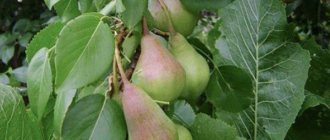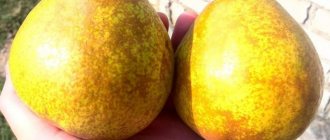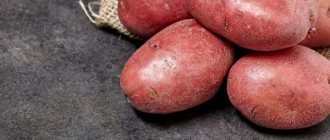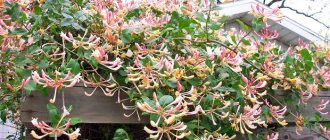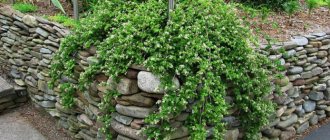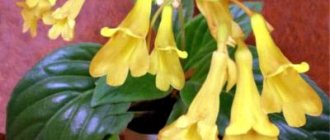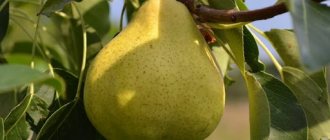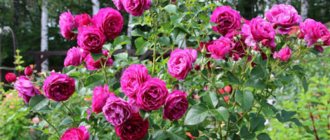Carmen pear variety.
Description of the variety
Although in 1992 the Carmen pear variety was included in the State Register, unfortunately, this variety was not deservedly widespread. Carmen pear is a summer variety and is distinguished by its bright color and dense compact crown. The variety was bred specifically for the Central region of Russia.
Characteristics of wood
The trunk of the Carmen pear grows up to 3 meters in height, the crown is very compact, pyramidal, the shoots are brownish-brown. The buds are small, cone-shaped. The leaves grow at an angle in relation to the branches, have an oval, slightly concave shape, and are glossy green.
Columnar-shaped Carmen pear.
Description of fruits
Ripe fruits of the Carmen pear weigh from 150 to 200 grams, they are medium in size and ideal in shape. The skin of the fruit is dry with many inclusions. The stalk is small but dense. The pear pulp is slightly oily, juicy, tastes sweet with a slight sourness, harmonious, and there is no hint of astringency.
The shade of ripe fruit is a real highlight. It is almost completely covered with a brownish-burgundy blush.
Soil preparation
The soil should be prepared in advance, add 3-4 kg of organic fertilizers per hole.
Ripsalidopsis: home care (photo)
Dig a small hole for planting so that the rhizome fits in the soil, and the place for grafting the pear is above the soil. Superphosphates or fertilizers with potassium, well mixed with the soil, should be placed in the planting hole. After such preparation, you can plant the tree, then water it well.
When adding organic matter to the soil, fertilizers must be separated from the roots of the tree, sprinkled well with soil, taking into account that it sags.
Pear roots are weak, so it is not recommended to use mineral fertilizers when planting seedlings. The tree may develop poorly or even die.
Reviews
Vera Fedorovna
Voronezh
Everyone in my family loves pears; we have a huge garden. A friend advised me to plant the Carmen pear variety, and finally we reaped the first harvest. In principle, we are satisfied with the result; the fruits are sweet, juicy, and very beautiful. It's a pity that the quantity is small.
Irina
Lipetsk
Good variety. It does not stand out in terms of productivity, but given its decorative appearance and compactness, it deserves attention. Enough to eat, while they are sweet and juicy, they still disappear quickly.
Vitaly
Novomoskovsk
The Carmen pear variety is like the flowers on a gypsy’s dress - large, bright, catchy. All jokes aside, very tasty fruits, juicy and sweet, beautiful. But they are few and far between.
Watering and fertilizing
The basis for proper cultivation of the Carmen pear in the first years after planting is the competent and timely formation of the crown. However, for full and proper development, young fruit plantings require regular watering and systematic feeding.
To reduce the need to apply fertilizers in the first years of a pear’s life, you need to properly prepare the area for planting. Fertile soil should be poured into a pre-dug planting hole with the addition of 30-35 kg of humus or high-quality compost, no more than 0.17 kg of superphosphate and about 0.2 kg of potassium chloride. For the root system of a fruit seedling, this amount of nutrients will be enough for rapid adaptation and rooting. Immediately after planting, the first loosening of the soil in tree trunk circles is carried out to a depth of 10-12 cm.
In the first two months after planting, fruit trees need abundant and regular watering. When watering, at least 30 liters of water are consumed for each young plant. After watering and shallow loosening, the tree trunk circles should be mulched with organic matter. In autumn and spring, plants need moisture-recharging irrigation.
Two years after planting, in early spring, it is necessary to apply about 20-30 g of nitrogen-containing fertilizers (per 1 sq. m). Approximately three years after planting, regular autumn digging should be carried out with the addition of 30 g of phosphorus, 20 g of potassium and 10 kg of organic matter. A good result is achieved by applying a solution of mullein or chicken manure from the fifth year of fruit plant life. It should be remembered that all fertilizing is carried out after the soil has been thoroughly moistened.
Landing
The Carmen pear variety must be planted correctly. She is picky about location. You can read about how to properly plant a Carmen tree and the features of all procedures using the links below.
How to plant a pear tree correctly
At what distance to plant pears?
How to choose pear seedlings
How to replant a pear
Characteristics
Fruits from the Carmen pear variety can be expected already in the fifth year after planting . She has an average precociousness . The fruits reach maturity in the second half of August , and the period of their consumption is two weeks.
Conference and Summer Williams can be used as pollinators for this pear variety .
The pear variety "Carmen" is characterized by average frost resistance and average yield , which is characterized by slow growth.
The following varieties are distinguished by good frost resistance: Naryadnaya Efimova, Lira, Moskvichka, Lesnaya Krasavitsa and Kupava.
The fruits have excellent transportability and excellent consumer qualities . They are widely used for making jam, jam, marmalade and compotes.
Pear trees of the "Carmen" variety are considered durable, as they live from 25 to 50 years.
Care
The Carmen pear variety is quite whimsical and capricious. It is necessary to feed it properly to stimulate fruiting. You can read about feeding and other procedures for caring for the Carmen pear using the links in the articles below.
How to care for a pear Pruning a pear Pruning a columnar pear Treating a pear from diseases and pests Feeding a pear How to water a pear
What type does it belong to?
The Carmen pear is a summer table pear variety. The Carmen pear is distinguished by its early ripening period, the harvest period is the third ten days of July, the shelf life is until October. Winter hardiness is below average and the variety is relatively resistant to diseases.
Summer varieties also include: Rossoshanskaya beautiful, Sverdlovchanka, Duchess, Tonkovetka and Chizhovskaya.
Diseases and pests
The Carmen pear tree has good immunity. It is protected from pests and many diseases. For prevention, you need to carry out a number of procedures that will help improve resistance. You can read about them in more detail in the articles linked below.
Dangerous Pear Pests
Pears often suffer from pests, they affect the leaves, bark and fruits.
In this article, we have selected 11 of the most harmful insects that harm pear trees, and also ways to destroy them.
Diseases of pear trees
To get what they cherish, gardeners have to work hard, and the reason for this is pear diseases.
Read about 19 common pear diseases and how to combat them.
Where to buy columnar pears
You can buy columnar pear seedlings on our website of the KFH Fruit Garden nursery. All you need is to select the desired variety of pear, then move it to the Cart and pay. After this, our specialist will contact you and provide you with a track number by which you can track your parcel.
Agricultural technology
Pear planting can be done in early May or late October. Choose a site that is well-lit, level, and a slight slope is allowed. The plant is not particularly picky about soils; loam, chernozem, and soddy-podzolic soil are suitable. The groundwater level to the surface should not be higher than 2.0 - 2.5 meters, since our heroine cannot tolerate stagnation of moisture in the roots. Watering is carried out as needed, taking into account natural precipitation. It is advisable to keep the tree trunk circle clean and not plant other plants in it. Since the branches grow at an acute angle, the wood connection is not very strong. To correct the situation, in the first years, when the crown is being formed, the branches should be given a more horizontal position using stretching. The rest of the agricultural technology corresponds to the standard one.
Carmen has a number of advantages. The compact size of the crown allows you to save space in the garden. Resistance to the main crop diseases - scab and septoria - makes care easier. True, in epiphytic years, without preventive treatments, the plant will not be able to maintain disease resistance at a high level. Gardeners especially value bright, fully colored pear fruits that have good taste. But one should not remain silent about the shortcomings of the variety. After all, knowing the weaknesses of a plant, you can easily avoid troubles associated with them. Thus, due to insufficient frost resistance, trees, especially at a young age, should be insulated in winter. Also during this period, the trunks should be protected from rodents. But the biggest drawback is still considered to be the slowly increasing yield.
Reproduction of dwarf pears
Propagating this crop by seed can be difficult because it requires a lot of time and effort. Also, this method is not suitable for obtaining all varieties of columnar pear. That's why gardeners use other popular methods.
Vaccination
Columnar pears are either seeded or grafted. Seed pears are bred naturally, which is facilitated by obtaining real genes. Dwarf pear seedlings are grafted onto rootstocks such as serviceberry or quince. It is recommended to graft onto the rootstock in late April-early May. It is advisable to do this early in the morning or evening, but it is also possible during the day if the weather is cloudy. Cuttings for grafting are prepared in winter, and during the procedure only clean and sharp instruments are used.
Step by step process:
- A pear is grafted in several ways: by the bark, in a split and in a side cut.
- For grafting, scion cuttings 70-80 cm long, prepared from the winter and stored in a cool place, are used.
- Before grafting, all fruit branches on the selected rootstock are cut off, leaving only 40 cm of their length.
- Start grafting cuttings of columnar pear.
- The grafting site is tightly wrapped with electrical tape and lubricated with garden varnish. The survival period lasts from 20 to 30 days.
A clear example of grafting a pear to shadberry is the following video:
By cuttings
To propagate in this way, you need to prepare green cuttings in advance, each one should be about 25-30 cm long. Each cutting should have at least 5 leaves and 2 internodes. A special root former solution is diluted in a separate container, usually Kornevin. Next, place the cuttings, peeled from the bottom, in this solution for 48 hours. This promotes faster rooting of cuttings.
Then the cuttings are buried in soil mixed with a small part of sphagnum. If all the conditions of this propagation method are met, the cuttings take root quickly.

